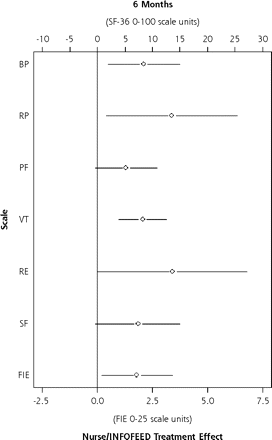A controlled trial of methods for managing pain in primary care patients with or without co-occurring psychosocial problems
- PMID: 16868238
- PMCID: PMC1522168
- DOI: 10.1370/afm.527
A controlled trial of methods for managing pain in primary care patients with or without co-occurring psychosocial problems
Abstract
Purpose: Pain, a common reason for visits to primary care physicians, is often not well managed. The objective of this study was to determine the effectiveness of pain management interventions suitable for primary care physicians.
Methods: Patients from 14 rural primary care practices (47 physicians) who reported diverse pain problems with (n = 644) or without (n = 693) psychosocial problems were randomized to usual-care or intervention groups. All patients in the intervention group received information tailored to their problems and concerns (INFO). These patients' physicians received feedback about their patients' problems and concerns (FEED). A nurse-educator (NE) telephoned patients with pain and psychosocial problems to teach problem-solving strategies and basic pain management skills. Outcomes were assessed with the Medical Outcomes Study 36-Item Short-Form and the Functional Interference Estimate at baseline, 6 months, and 12 months.
Results: Patients with pain and psychosocial problems randomized to INFOFEED+NE significantly improved on the bodily pain (P = .011), role physical (P = .025), vitality (P <.001), role emotional (P = .048), and the Functional Interference Estimate (P = .027) scales compared with usual-care patients at 6 months. These improvements were maintained at the 12-month assessment even though these patients had received, on average, only 3 telephone calls. Compared with usual-care patients, at 6 months patients who received INFOFEED alone experienced minimal improvements that were not sustained at the 12-month assessment.
Conclusions: For patients with pain and psychosocial problems, telephone-based assistance resulted in significant, sustained benefit in pain and psychosocial problems.
Figures



Similar articles
-
Panel-based pain management in primary care. a pilot study.J Pain Symptom Manage. 2001 Jul;22(1):584-90. doi: 10.1016/s0885-3924(01)00301-3. J Pain Symptom Manage. 2001. PMID: 11516600 Clinical Trial.
-
Telephone-based self-management of osteoarthritis: A randomized trial.Ann Intern Med. 2010 Nov 2;153(9):570-9. doi: 10.7326/0003-4819-153-9-201011020-00006. Ann Intern Med. 2010. PMID: 21041576 Clinical Trial.
-
Behavioural modification interventions for medically unexplained symptoms in primary care: systematic reviews and economic evaluation.Health Technol Assess. 2020 Sep;24(46):1-490. doi: 10.3310/hta24460. Health Technol Assess. 2020. PMID: 32975190 Free PMC article.
-
Teens Taking Charge: A Randomized Controlled Trial of a Web-Based Self-Management Program With Telephone Support for Adolescents With Juvenile Idiopathic Arthritis.J Med Internet Res. 2020 Jul 29;22(7):e16234. doi: 10.2196/16234. J Med Internet Res. 2020. PMID: 32723728 Free PMC article. Clinical Trial.
-
Telephone interventions for symptom management in adults with cancer.Cochrane Database Syst Rev. 2020 Jun 2;6(6):CD007568. doi: 10.1002/14651858.CD007568.pub2. Cochrane Database Syst Rev. 2020. PMID: 32483832 Free PMC article.
Cited by
-
Effectiveness of Models Used to Deliver Multimodal Care for Chronic Musculoskeletal Pain: a Rapid Evidence Review.J Gen Intern Med. 2018 May;33(Suppl 1):71-81. doi: 10.1007/s11606-018-4328-7. J Gen Intern Med. 2018. PMID: 29633140 Free PMC article.
-
Incorporating PROMIS Symptom Measures into Primary Care Practice-a Randomized Clinical Trial.J Gen Intern Med. 2018 Aug;33(8):1245-1252. doi: 10.1007/s11606-018-4391-0. Epub 2018 Apr 5. J Gen Intern Med. 2018. PMID: 29623512 Free PMC article. Clinical Trial.
-
Mixed methods and diverse perspectives.Ann Fam Med. 2006 Jul-Aug;4(4):290-1. doi: 10.1370/afm.614. Ann Fam Med. 2006. PMID: 16871649 Free PMC article. No abstract available.
-
Psychosocial stress and anxiety in musculoskeletal pain patients with and without depression.Gen Hosp Psychiatry. 2009 Mar-Apr;31(2):116-22. doi: 10.1016/j.genhosppsych.2008.10.003. Epub 2008 Nov 22. Gen Hosp Psychiatry. 2009. PMID: 19269531 Free PMC article.
-
Evaluative criteria for qualitative research in health care: controversies and recommendations.Ann Fam Med. 2008 Jul-Aug;6(4):331-9. doi: 10.1370/afm.818. Ann Fam Med. 2008. PMID: 18626033 Free PMC article.
References
-
- Mantyselka PT, Turunen JH, Ahonen RS, Kumpusalo EA. Chronic pain and poor self-rated health. JAMA. 2003;290:2435–2442. - PubMed
-
- Gureje O, Von Korff M, Simon GE, Gater R. Persistent pain and well-being: a World Health Organization Study in Primary Care. JAMA. 1998;280:147–151. - PubMed
-
- Blyth FM, March LM, Brnabic AJ, Cousins MJ. Chronic pain and frequent use of health care. Pain. 2004;111:51–58. - PubMed
-
- Stewart WF, Ricci JA, Chee E, Morganstein D, Lipton R. Lost productive time and cost due to common pain conditions in the US workforce. JAMA. 2003;290:2443–2454. - PubMed
-
- Kroenke K, Jackson JL, Chamberlin J. Depressive and anxiety disorders in patients presenting with physical complaints: clinical predictors and outcome. Am J Med. 1997;103:339–347. - PubMed
Publication types
MeSH terms
Grants and funding
LinkOut - more resources
Full Text Sources
Medical
